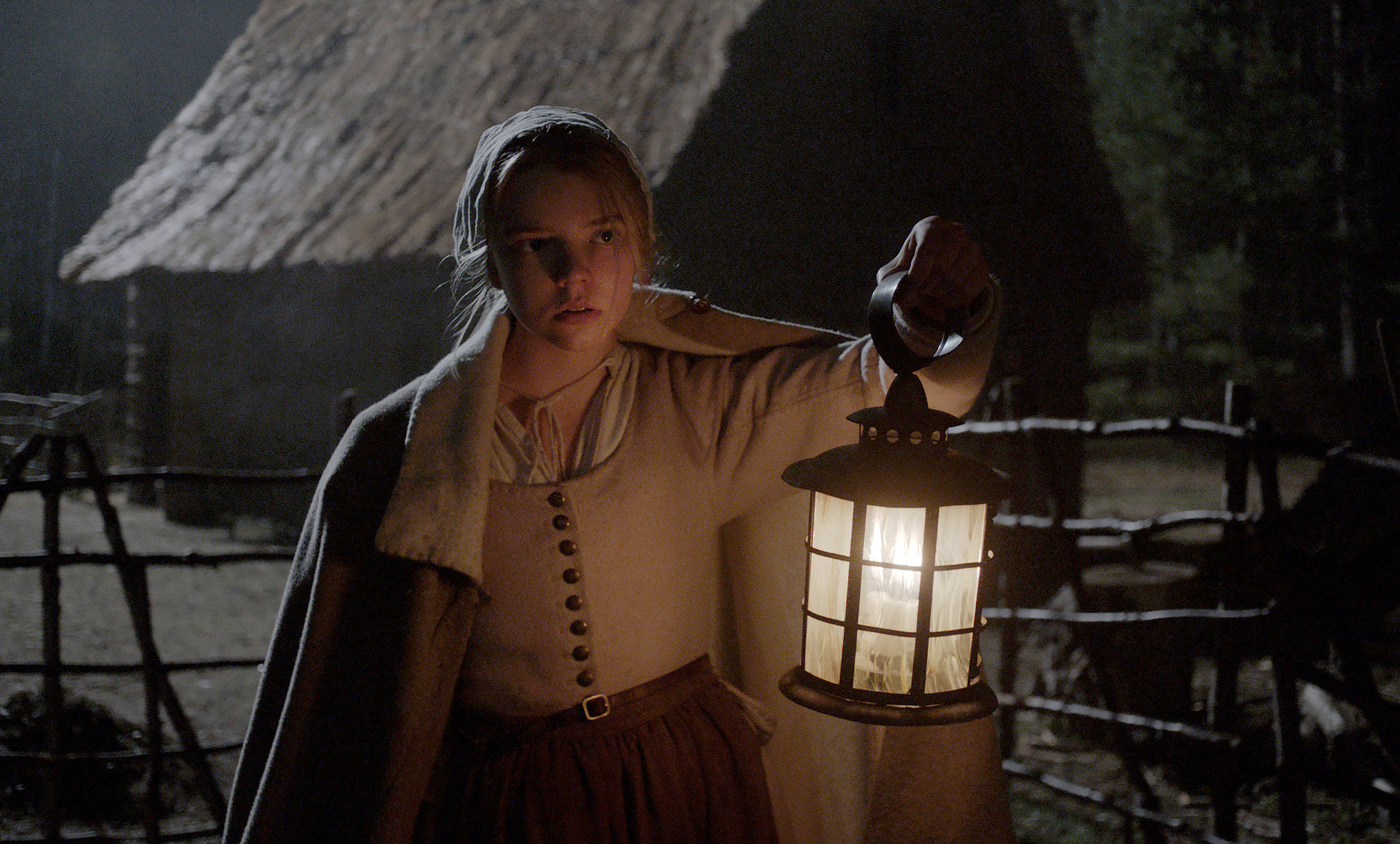
The first thing The Witch reveals is that the family at its center is too good for their Puritan neighbors. That’s right. The group of people whose very name has come to mean austere purity is supposedly steeped in sin compared to the family at the film’s center. So, the family leaves their community and ventures out into the wilderness alone. As anyone who has ever watched a horror movie like The Witch knows, alone is the worst way to be.
Sundance stand-out The Witch chronicles what happens to this family out there on their own. By the end, their supposed exceptional holiness is something beyond suspect. Every saint is a sinner, it seems, and every sinner gets her or his due.
The film is beautiful and terrifying. First we’ll tackle the beauty. Then we’ll take on the terror.
Director Robert Eggers and his team have put together a remarkably realistic world right down to the tools they use to harvest their scant crops, the clothes they soil, and the vernacular they employ. Their speech is the most striking aspect of the film. Simple conversations sound like devout prayers and unholy incantations when cast in King James English. Many of the prayers and whatnot are actual prose recorded in diaries during the 16th and 17th century. The filmmakers even light the film like a Renaissance painting, like Rembrandt come to life and out for blood.
By drawing the verbiage from the time period, The Witch has also pulled up the kind of belief in the supernatural that made the Puritans prone to literal witch hunts. The family is devout. They call out to God for forgiveness, mercy, salvation, relief from both their natural and supernatural torments. One particularly harrowing scene has the family jointly reciting the 23rd Psalm in hopes of fending off a suspected demonic presence. There is conviction in their prayer of a kind we don’t often see in movies or in real life.
And the devil is there too, though it takes many forms. Figuring out which form it is going to assume next is where most of the film’s narrative terror lies. The rest of it is in The Witch’s use of patient cinematography. Every door left open becomes evil’s next possible point of entry. Every tick of the second hand ratchets up the suspense. I don’t have a lot of experience with horror films, but The Witch does the terrifying trick for me, and given its popularity at Sundance, it seems to do the trick for most other people too.
The Witch’s movie world is one where people are sinful, and they reap the consequences for their sins. The family members’ individual temptations are the typical ones. The pubescent boy leans toward lust. The father is prideful. The young children are vicious, cruel, and disobedient. The mother and older daughter are at odds over who really runs the household. All these purulent proclivities are depicted visually by the film as well, granting The Witch a sense of delightful visual irony. Even if the horror isn’t to your taste, the moral humor might be. It’s what got me through.
SPOILERS follow in this next paragraph. I won’t reveal plot details, but if you don’t want to know what happens thematically in the end, stop reading now.
The Witch isn’t a film where good wins. In fact, if anything, good is shown to be powerless before evil. Cast out of their community (by the family’s own will), the family has no where else to turn but to darkness. This is foreshadowed in the film’s opening minutes as the family leaves the village and disappears into the gathering twilight as they wagon into the woods. By the time all that happens has happened, they really don’t have anywhere else to go but deeper into the darkness. I could make a hermeneutical leap here and say the film is suggesting that divorced from Christian community, there is no where to go but into darkness, but that certainly does not seem like the film’s intention. It revels in evil a bit too much for me to believe that it had any other goal from the get go. Still, The Witch is a fantastically crafted, terrifically terrifying film that true to its convictions to its terrible end.
The first thing The Witch reveals is that the family at its center is too good for their Puritan neighbors. That’s right. The group of people whose very name has come to mean austere purity is supposedly steeped in sin compared to the family at the film’s center. So, the family leaves their community and ventures out into the wilderness alone. As anyone who has ever watched a horror movie like The Witch knows, alone is the worst way to be.
Sundance stand-out The Witch chronicles what happens to this family out there on their own. By the end, their supposed exceptional holiness is something beyond suspect. Every saint is a sinner, it seems, and every sinner gets her or his due.
The film is beautiful and terrifying. First we’ll tackle the beauty. Then we’ll take on the terror.
Director Robert Eggers and his team have put together a remarkably realistic world right down to the tools they use to harvest their scant crops, the clothes they soil, and the vernacular they employ. Their speech is the most striking aspect of the film. Simple conversations sound like devout prayers and unholy incantations when cast in King James English. Many of the prayers and whatnot are actual prose recorded in diaries during the 16th and 17th century. The filmmakers even light the film like a Renaissance painting, like Rembrandt come to life and out for blood.
By drawing the verbiage from the time period, The Witch has also pulled up the kind of belief in the supernatural that made the Puritans prone to literal witch hunts. The family is devout. They call out to God for forgiveness, mercy, salvation, relief from both their natural and supernatural torments. One particularly harrowing scene has the family jointly reciting the 23rd Psalm in hopes of fending off a suspected demonic presence. There is conviction in their prayer of a kind we don’t often see in movies or in real life.
And the devil is there too, though it takes many forms. Figuring out which form it is going to assume next is where most of the film’s narrative terror lies. The rest of it is in The Witch’s use of patient cinematography. Every door left open becomes evil’s next possible point of entry. Every tick of the second hand ratchets up the suspense. I don’t have a lot of experience with horror films, but The Witch does the terrifying trick for me, and given its popularity at Sundance, it seems to do the trick for most other people too.
The Witch’s movie world is one where people are sinful, and they reap the consequences for their sins. The family members’ individual temptations are the typical ones. The pubescent boy leans toward lust. The father is prideful. The young children are vicious, cruel, and disobedient. The mother and older daughter are at odds over who really runs the household. All these purulent proclivities are depicted visually by the film as well, granting The Witch a sense of delightful visual irony. Even if the horror isn’t to your taste, the moral humor might be. It’s what got me through.
SPOILERS follow in this next paragraph. I won’t reveal plot details, but if you don’t want to know what happens thematically in the end, stop reading now.
The Witch isn’t a film where good wins. In fact, if anything, good is shown to be powerless before evil. Cast out of their community (by the family’s own will), the family has no where else to turn but to darkness. This is foreshadowed in the film’s opening minutes as the family leaves the village and disappears into the gathering twilight as they wagon into the woods. By the time all that happens has happened, they really don’t have anywhere else to go but deeper into the darkness. I could make a hermeneutical leap here and say the film is suggesting that divorced from Christian community, there is no where to go but into darkness, but that certainly does not seem like the film’s intention. It revels in evil a bit too much for me to believe that it had any other goal from the get go. Still, The Witch is a fantastically crafted, terrifically terrifying film that true to its convictions to its terrible end.

Elijah Davidson is Co-Director of Brehm Film and Senior Film Critic. Find more of his work at elijahdavidson.com.
The Green Knight is the old tale told rather straight with a gothic sensibility, meaning there are no contemporary action theatrics to see here, just weird fantasy stuff.